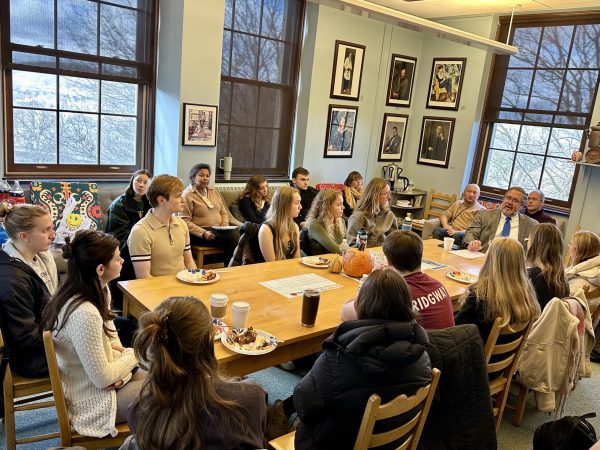The Unseen Effects of Climate Change
The first Environmental Studies Brown Bag of the semester took place on Friday, January 30 at the African, Latin American, Asian American and Native American (ALANA) Cultural Center.
Professor of Geology Amy Leventer provided insight into the many implications of global warming in a lecture titled “What’s going on at the top and bottom of the world, and how it matters to the rest of the world.”
Leventer has conducted extensive research regarding how carbon emissions affect both the Arctic and Antarctic. To begin her discussion, she detailed the extensive differences between these two icy regions.
The Arctic is an ocean basin surrounded by continents, which is annually covered by sea ice that forms from frozen ocean water. It is home to polar bears and the native Inuit people.
The Antarctic is the opposite of the Arctic: it is a continent surrounded by ocean. It is covered by glacial ice, which is frozen precipitation sitting on top of land. Unlike the Arctic, the Antarctic has no native inhabitants and is home only to penguins.
The only people in the Antarctic are those conducting scientific research.
After describing both regions, Professor Leventer expressed the extent to which both the Arctic and Antarctic are physically affected by global warming.
“Both of these areas are among the most strongly impacted by global warming, but essentially have zero carbon emissions,” Leventer said.
She stressed the clear destructive role of global warming on earth’s climate and ice caps.
She explained the potential of permanent, irreversible damage to the environment due to current global warming rates.
“The fear is that, as we melt ice in the Arctic and the Antarctic, we will reach a point of no return–a tipping point–beyond which we cannot reverse the effects of our actions,” Leventer said.
The loss of ice in the Arctic and Antarctic has implications that stretch beyond the physical appearance of these areas. As drastic melting occurs with increasing frequency, political issues regarding various economic interests in these areas are brought into the discussion.
“The question then that comes to mind is, well, if we lose all that ice, who owns that area that’s underneath the ice? This will then govern how transport in the Arctic can take place. This is going to govern shipping routes,” Leventer said.
“The second thing that that’s going to have an impact on [this issue] is who owns all the resources that are in the sea bed. We don’t know exactly what the resources are, because it’s really difficult to look there because there’s still a lot of sea ice, but the investigations that have taken place so far suggest that there is quite a bit of oil and natural gas in the Arctic, as well as minerals and metals. So, who gets to mine those? That depends on how you draw [future territorial lines].”
As ice melts and gives way to new shipping routes, the United States must examine its ability to play a political role in the scientific discoveries and claims that will soon be taking place.
“Almost every single one of the United States Coast Guard ice-breaker [ships] is about to be decommissioned. It would cost more to refurbish it than to build a new one. So we are, at this point, completely unprepared to work in the Arctic,” Leventer said. Students in attendance found the lecture to be very informative and illuminating, as it challenged them to think of both the environmental and political consequences of global warming.
“I thought it was interesting how [Professor Leventer] connected politics with the topic of global warming and showed a consequence that most Americans don’t think about,” first-year Colleen Donlan said.
“The talk opened up my eyes in regard to the conservation and scientific efforts that are going on in the Arctic and Antarctic. It is clear that humanity is having ill effects on these parts of the world and the impact of that will negatively affect the planet as a whole,” first-year Matt Leo said.





